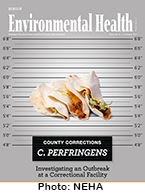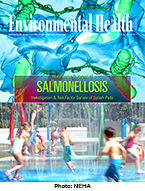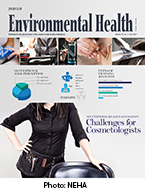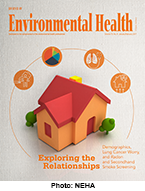EHSB in the NEHA Journal of Environmental Health
2017 Direct from CDC columns
NEHA’s Journal of Environmental Health features a column from the Environmental Health Services Branch (EHSB) in every issue. These articles from EHSB and guest authors from CDC highlight a variety of concerns, opportunities, challenges, and successes in environmental public health.
Quick links for earlier columns in: 2016, 2015, 2014, 2013, 2012, 2011, 2010, 2009, 2008, 2007, 2006.

Success Stories From CDC’s Safe Water for Community Health Grantees [PDF – 318 KB] – CDC’s Safe Water for Community Health (Safe WATCH) program helps state and county health agencies improve their safe drinking water programs for household wells. In this column, CDC’s Brian Hubbard discusses grantee success stories from the first year of the Safe WATCH. This article was published in the October 2017 issue [PDF – 194 KB] of the Journal of Environmental Health.

Food Safety Innovations in Federal Guidelines [PDF – 402 KB] – The Food Service Guidelines for Federal Facilities apply to concession and vending operations at federal facilities. In this column, CDC fellows Lauren Lipcsei and Taylor Radke discuss how innovative criteria could further reduce the risk of foodborne illness in federal foodservice operations. This article was published in the September 2017 issue [PDF – 176 KB] of the Journal of Environmental Health.

Understanding the Needs, Challenges, Opportunities, Vision, and Emerging Roles in Environmental Health [PDF – 208 KB] – Recent public health crises are examples of diseases and events requiring a response from a prepared, sufficient, and equipped environmental health (EH) workforce. In this column, CDC’s CDR Justin Gerding and partners from NEHA and Baylor University describe an initiative to understand EH professional demographics, education and training, experience, areas of practice, and current and future needs. This article was published in the July/August 2017 issue [PDF – 244 KB] of the Journal of Environmental Health.

Tools To Drive Quality Improvement of Vector Control Services. [PDF – 624 KB] – Quality improvement efforts are important for increasing the efficiency and effectiveness of environmental health programs and activities. In this column, LCDR Justin Gerding from CDC and Vanessa Lamers from the Public Health Foundation discuss how a population health driver diagram can capture and detail specific activities to address community health objectives. This article was published in the June 2017 issue [PDF – 164 KB] of the Journal of Environmental Health.

Minimizing Risk of Illness and Injury at Public Aquatic Facilities by Maximizing the Power of Aquatic Facility Inspection Data. [PDF – 336 KB] – When environmental health practitioners enforce state or local codes during pool inspections, they prevent illness and injuries at public aquatic facilities. In this column, CDC’s Michele Hlavsa, CDR Jasen Kunz, and Michael Beach explain how health departments can use pool inspection data to improve aquatic health and safety. This article was published in the May 2017 issue [PDF – 160 KB] of the Journal of Environmental Health.

Using the National Environmental Assessment Reporting System to Enhance Foodborne Illness Outbreak Investigations in New York City Restaurants. [PDF – 224 KB] – Foodborne illness outbreak investigations identify and correct the environmental cause(s) of the outbreak so more people do not become ill. In this column, guest authors from the NYC Health Department explain how CDC’s NEARS provides tools for data collection and reporting to assist health departments with identifying causes of outbreaks in their communities. This article was published in the April 2017 issue [PDF – 164 KB] of the Journal of Environmental Health.

What Actions Are Health Departments Taking To Improve Safe Drinking Water Programs? [PDF – 312 KB] – One in nine American residents get their drinking water from private wells, which can be susceptible to waterborne contaminants. In this column, CDC’s Brian Hubbard and Vanessa Lamers from the Public Health Foundation discuss work with CDC’s Safe Water for Community Health grantees to address problems with wells in their communities. This article was published in the March 2017 issue [PDF – 164 KB] of the Journal of Environmental Health.

CDC Takes Action to Improve the Reporting of Environmental Assessment Data During Foodborne Illness Outbreak Investigations. [PDF – 371 KB] – Environmental assessments are an essential component of foodborne illness outbreak investigations. In this article, CDC’s Erik Coleman discusses NEARS, a surveillance system that collects environmental assessment data from outbreak investigations. This article was published in the in the January/February 2017 issue [PDF – 165 KB] of the Journal of Environmental Health.
- Page last reviewed: January 6, 2017
- Page last updated: September 29, 2017
- Content source:


 ShareCompartir
ShareCompartir